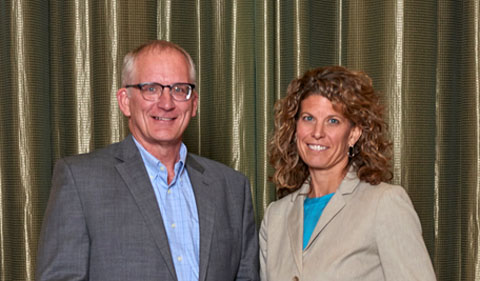
Steve Evans and Julie Owens
Behavioral and Organizational Approaches Lead the Way
A careful review of talk therapies for attention deficit hyperactivity disorder (ADHD) by Dr. Steve Evans, Dr. Julie Sarno Owens, and graduate student Nora Bunford from Ohio University’s Psychology Department concluded that, among talk therapies, behavioral approaches and organizational interventions have the strongest scientific evidence supporting their use.
Their article on “Evidence-Based Psychosocial Treatments for Children and Adolescents with Attention-Deficit/Hyperactivity Disorder” was published this month in the Journal of Clinical Child & Adolescent Psychology (JCCAP).
Studies suggest that ADHD affects between 5 to 10 percent of youths and causes significant and distressing impairment, particularly in academic and social contexts. A few brief videos with information for parents are available on www.effectivechildtherapy.com, according to a news release by the Society of Clinical Child & Adolescent Psychology.
The authors examined more than 20 peer-reviewed studies published since 2007 in their update of a similar review from 2008 by Drs. William Pelham and Gregory Fabiano. Using a five level ranking system, with the first level representing treatments with the best support and the fifth level representing treatments with no support, the authors categorized nine different treatment approaches, with four ranked at Level 1 or best support:
- behavioral parent training
- behavioral classroom management
- combined (i.e., parent and school) behavior management
- organization training
Behavioral management approaches involve teaching caregivers and/or teachers to administer contingent responses consistently to help children with ADHD get along with others, follow rules, and complete tasks. The organization interventions involve training children/teens in using specific organizational skills, such as maintaining a checklist for homework and keeping their belongings organized.
Combined training approaches, involving a combination of organization skills with other skill training, like teaching children academic skills, as well as how to set and achieve goals for success in social situations , ranked at level 2 support, the second highest.
Neurofeedback approaches were rated at Level 3 (i.e., “might work”), and cognitive training approaches were rated at Level 4 (i.e., “experimental”).
Social skills training alone was rated at Level 5 (i.e., “does not work”), indicating that the approach has been tested and evidence was not promising. No other psychological treatment met scientific standards to suggest that it could reliably or meaningfully reduce impairment and symptoms of youth with ADHD.
JCCAP is the flagship journal of the Society for Clinical Child & Adolescent Psychology (SCCAP), Division 53 of the American Psychological Association. SCCAP is a non-profit organization whose mission is to encourage the development and advancement of clinical child and adolescent psychology through integration of its scientific and professional aspects. SCCAP promotes scientific inquiry, training, professional practice, and public policy in clinical child and adolescent psychology as a means of improving the welfare and mental health of children, youth, and families.
Abstract: The purpose of this research was to update the Pelham and Fabiano (2008) review of evidence-based practices for children and adolescents with attention-deficit/hyperactivity disorder. We completed a systematic review of the literature published between 2007 and 2013 to establish levels of evidence for psychosocial treatments for these youth. Our review included the identification of relevant articles using criteria established by the Society of Clinical Child and Adolescent Psychology (see Southam-Gerow & Prinstein, in press) using keyword searches and a review of tables of contents. We extend the conceptualization of treatment research by differentiating training interventions from behavior management and by reviewing the growing literature on training interventions. Consistent with the results of the previous review we conclude that behavioral parent training, behavioral classroom management, and behavioral peer interventions are well-established treatments. In addition, organization training met the criteria for a well-established treatment. Combined training programs met criteria for Level 2 (Probably Efficacious), neurofeedback training met criteria for Level 3 (Possibly Efficacious), and cognitive training met criteria for Level 4 (Experimental Treatments). The distinction between behavior management and training interventions provides a method for considering meaningful differences in the methods and possible mechanisms of action for treatments for these youth. Characteristics of treatments, participants, and measures, as well as the variability in methods for classifying levels of evidence for treatments, are reviewed in relation to their potential effect on outcomes and conclusions about treatments. Implications of these findings for future science and practice are discussed.



















Comments